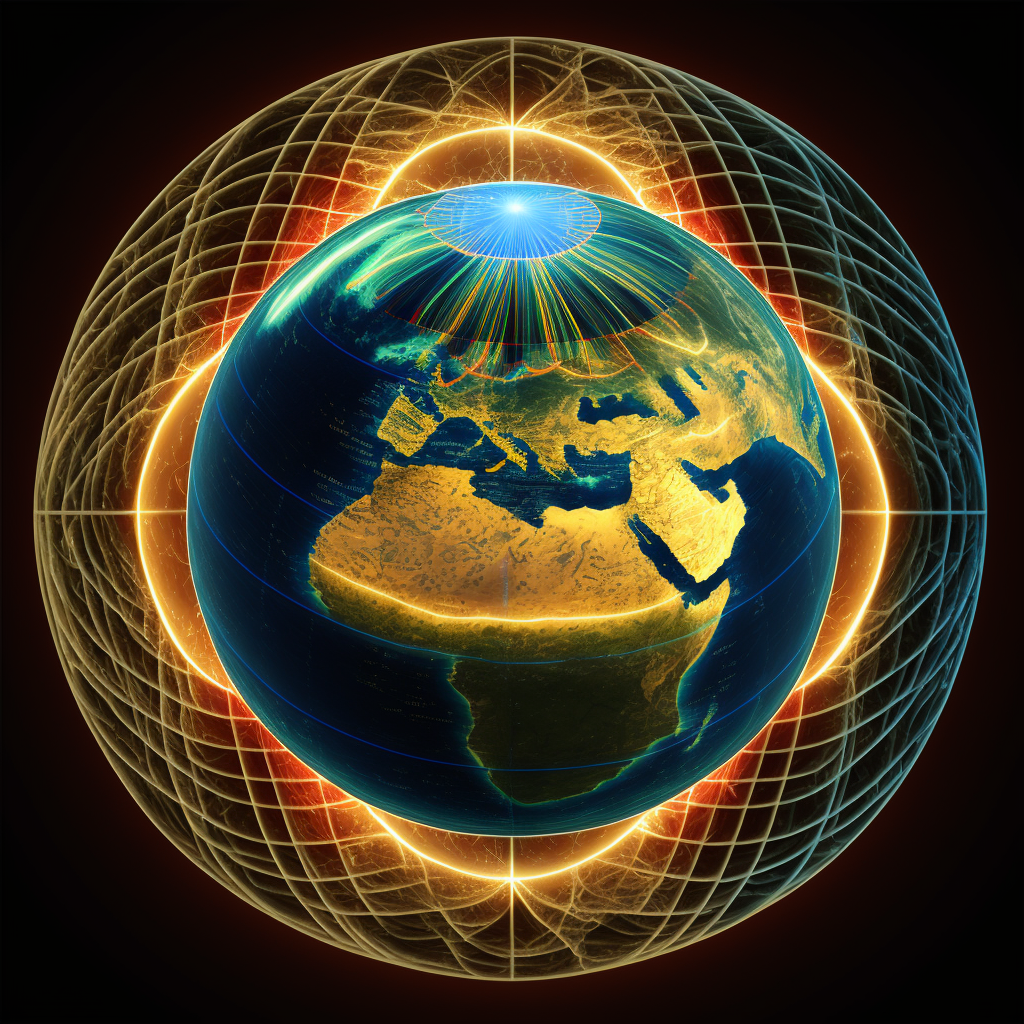Understanding Schumann Resonance
& Its Connection to Spiritual Awakening
Understanding Schumann Resonance (SR)
Schumann Resonance (SR) refers to the natural electromagnetic resonances that occur within the Earth’s atmosphere. These resonances, discovered by physicist Winfried Otto Schumann in 1952, are caused by the interaction of the Earth’s surface with the ionosphere. This results in standing waves in the atmosphere and, more particularly, in the cavity created by the planet’s surface and ionosphere. The main causes of these resonances are electrical phenomena like lightning strikes and other atmospheric electrical phenomena. The Schumann resonance’s fundamental frequency is about 7.83 Hz, and its higher harmonics are about 14, 20, 26, and 33 Hz.
“The Earth‘s frequency or ’heartbeat‘ (Schumann Resonance) influences human brain activity and even human consciousness. It’s a fascinating link between our brain and the natural world.”
– Dr. Joe Dispenza
Reading Schumann Resonance Charts
Learning how to interpret the charts is essential for a deeper understanding of the Schumann Resonance. These graphs offer details on the resonance’s magnitude, frequency, Q-factor, and electromagnetic environment.
The basic Schumann Resonance spectrogram is a 3D graph. The x axis represents time (hours) and the y axis represents frequency (hertz). The color represents amplitude with blues/purples for lower amplitudes, white for the highest. There are often four bands that you can see on the main chart. These are called modes and are represented as separate plots on the other charts – denoted as A1, A2, A3, and A4 on the amplitude chart, F1, F2, F3, and F4. F1 on the frequency chart, and so on. The ranges for these bands is as follows: 7.53-8.12 (fundamental), 13.10-14.60, 19.30-21.00, and 24.10-26.40.
Amplitude: The Schumann Resonance’s power or intensity is referred to as its amplitude. Stronger resonance is indicated by higher amplitude values, whereas weakened resonance is suggested by lower values. Typically, the vertical axis of a chart is used to indicate amplitude, with higher values at the top and lower values at the bottom.
Frequency: Frequency represents the number of oscillations or cycles per second, measured in Hertz (Hz). Although the Schumann Resonance’s basic frequency is roughly 7.83 Hz, there are a number of higher harmonics that occur regularly. On a chart, frequency is typically plotted on the horizontal line.
Q-factor: The precision of a resonance peak is gauged by the Q-factor, also known as quality factor. Q factor indicates the sustainability of the energy; liken this to a pendulum with low friction that is able to sustain its momentum and movement far longer than a pendulum with high friction that fizzles out much more quickly. While a lower Q-factor suggests a wider and less defined peak, a higher Q-factor suggests a more distinct and narrow peak. By splitting the resonance frequency by the resonance peak’s bandwidth, the Q-factor can be determined.
Electromagnetic background: The Earth’s atmosphere’s ambient electromagnetic radiation is known as the electromagnetic backdrop. It is made up of both natural and man-made elements, such as solar radiation, electromagnetic pollution, and electricity. The backdrop of a Schumann Resonance chart can be thought of as a constant field or baseline against which the resonance peaks are seen.
I highly recommend this phenomenal video by Stefan Burns on YouTube: How to read Schumann Resonance Data.
To see the charts for yourself, visit the Space Observing System webpage. (Note: the site is presented in Russian, so it may be helpful to have a google translate plugin installed.)
Schumann Resonance Spectrogram
Amplitude
Frequency
Quality (Q) – Factors
Anomalies and Earth Weather Events
Lightning strikes and clouds can significantly affect the Schumann resonance. Each lightning strike releases a burst of electromagnetic waves that can stimulate the resonant frequencies of the Earth-ionosphere cavity, acting as a natural source of electromagnetic energy.
The following impacts on Schumann resonance can be seen during thunderstorms and increased lightning activity:
- Intensity: Because there are more lightning discharges during thunderstorms, the Schumann resonance’s strength may rise. The main cause of this rise in intensity is the result of a large number of small discharges generating electromagnetic waves that reinforce one another in the resonant cavity.
- Frequency variations: Storms can have an impact on Schumann resonance levels as well. The size of the Earth-ionosphere cavity can change, which can affect the resonant frequencies as the ionosphere’s height and composition shift as a result of weather events. The resonance frequencies can also vary as a result of regional variations in the atmosphere’s electrical conductivity.
- Spatial distribution: The spatial patterns of Schumann resonance can be affected by the lightning discharge dispersion. The Schumann resonance signals may exhibit stronger amplitudes in particular regions where lightning activity is concentrated, such as during large-scale storms. On the other hand, resonance signals may have more consistent strengths when lightning activity is more evenly spread throughout the world.
- Seasonal and diurnal variations: Thunderstorms follow particular seasonal and nocturnal patterns in the weather. As a consequence, these variations also affect the Schumann resonance. The Schumann resonance may be more pronounced in the summer than in the winter, for instance, when rains are more common in some areas. The intensity of the resonance varies daily because lightning activity usually peaks in the late afternoon and early evening.
- Solar activity: Solar activity has the potential to affect the Schumann resonance even though it is not directly linked to weather conditions. Solar radiation has the power to change the ionosphere’s composition and the extent of the Earth-ionosphere cavity. Consequently, variations in the frequencies and intensities of the resonant signals may result from the modulation of the Schumann resonance by solar activity. This is discussed below.
Anomalies and Solar Weather
Irregularities in Schumann Solar weather phenomena like solar flares, coronal mass ejections (CMEs), and geomagnetic disturbances can all result in resonance charts. These occurrences can result in abrupt amplitude increases and frequency changes, which can produce odd patterns or spikes in the chart.
The Earth’s ionosphere, which is crucial for the creation and spread of Schumann Resonances, can also be momentarily altered by solar weather events. These modifications may disrupt or modify the resonance patterns, which would then show up as anomalies on the chart.
- Ionospheric changes: The composition, height, and structure of the ionosphere can all be affected by solar radiation, especially during solar flares and CMEs. The Schumann Resonance’s resonant frequencies and intensities can vary as a result of these changes in the Earth-ionosphere cavity’s size.
- Geomagnetic storms: Geomagnetic storms, which are transient disturbances of the Earth’s magnetosphere, can be brought on by solar weather phenomena. These storms can affect the Schumann Resonance by changing the Earth-ionosphere cavity and the atmosphere’s electrical conductivity.
- Solar-terrestrial interactions: The Schumann Resonance frequencies and intensities can change as a result of the interplay between the solar wind and the Earth’s magnetic field, which can cause disturbances in the ionosphere. During times of higher solar activity, such as solar maximums in the 11-year solar cycle, these disruptions may be more noticeable.
- Solar cycle effects: The Schumann Resonance can also be influenced by the 11-year solar cycle, which is marked by successive intervals of high and low solar activity. Increased ultraviolet (UV) radiation and solar energetic particles during periods of high solar activity, such as solar maximums, may cause the ionosphere to become more ionized, changing the Earth-ionosphere cavity and possibly affecting the Schumann Resonance’s resonant frequencies and intensities.
- Atmospheric effects: Solar weather anomalies can alter the makeup, temperature, and pressure of the Earth’s atmosphere. The Schumann Resonance’s electromagnetic waves can have their propagation affected by these atmospheric shifts. The passage of electromagnetic radiation through the Earth-ionosphere cavity, for instance, can be impacted by variations in atmospheric gas distribution or ionosphere height.
Also note that weather events on Earth – such as intense thunderstorms that have lightning (particularly if they are close to the measuring location in Tomsk, Russia) – will influence the data. These may appear as the intense white spikes on the main Schumann Resonance map.
Is the Schumann Resonance Changing?
In 2023, there has been a significant increase in mode 2 (14 Hz) over the fundamental mode of 7.83 Hertz. This increase in the 14-15 hertz range actually corresponds to low-frequency beta waves which activate the sympathetic (fight-flight-freeze-fawn) nervous system response. This is very different from the base or fundamental range of 7.83, which correlates with a low-theta to alpha brain-wave state and activation of the parasympathetic nervous system.
Remember that alpha states are considered “light-trance” states. We often enter alpha states within a minute of watching television. Thus alpha states can also be indicative of how susceptible we are to conditioning and programing, but may also be used for soul-level information retrieval when the state is used actively and without sensory stimulation. Beta states are entered when we’re actively learning.
What does this mean? A few things:
- It could mean that the brain states in which we learn (beta) are being activated more. We’re waking up.
- Brain states in which we are susceptible to programming and conditioning are comparatively “decreasing.” (They are not really decreasing, per se, just in relative proportion to the typical relationship between the foundation or fundamental Mode 1 @ 7.83 Hz and Mode 2 @ 14Hz).
- If you’re someone that often taps into theta states to receive guidance and other information, you may find that entering this trance state is more difficult.
- We’re going to feel more energetic, but this might also trigger feelings of anxiety or restlessness. Remember too that when we’re in sympathetic mode, our digestion and immune processes are suppressed. We also shut down our excretory processes and thus we store toxins rather than releasing them from the body. Additionally, our sleep may be dramatically impacted. How do we combat this? Grounding, focusing on breathing, and generally maintaining mindful states.
I recommend the video by Stefan Burns – Schumann Resonances ARE RISING in 2023.
Understanding how Schumann Resonance Fluctuations Impact Us Physically
Changes or spikes in the Schumann Resonance might affect us physically in various ways. While the exact effects can vary among individuals, some possible impacts include:
- Sleep disturbances: Given that our brainwaves are thought to be influenced by these natural frequencies, fluctuations in the Schumann Resonance could possibly cause disruptions in our sleep patterns. Insomnia or restless sleep may result from this, as well as trouble getting asleep.
- Mood swings: Due to the connection between our brain activity and emotional state and the electromagnetic frequencies of the Earth, some people may experience mood swings, irritability, or a rise in anxiety as a result of changes in the Schumann Resonance.
- Fatigue or exhaustion: Due to the possibility that these frequencies have an impact on our body’s energy levels and circadian rhythms, abrupt shifts in the Schumann Resonance may cause feelings of fatigue or exhaustion.
- Headaches or migraines: For some people, variations in the Schumann Resonance can cause headaches or migraines because they are more sensitive to changes in the Earth’s electromagnetic frequencies.
- Altered cognitive function: Memory, focus, and decision-making are just a few of the cognitive processes that could be impacted by changes in the Schumann Resonance. This might be as a result of these frequencies’ possible effects on neural activity and brainwave synchronization.
- Increased stress: Due to the possibility that the electromagnetic environment of the Earth may have an impact on our bodies’ stress response, significant changes in the Schumann Resonance could result in a rise in stress levels.
It is crucial to remember that not everyone will feel the same physical effects from variations or peaks in the Schumann Resonance; these effects can differ greatly. While some individuals may not experience any effects at all, some may be more sensitive to these fluctuations than others. For instance, if you’re someone that is sensitive to the energetic changes that thunderstorms bring, you’re more likely to be impacted by fluctuations in the Schumann Resonance. Being aware of the potential consequences of variations in the Schumann Resonance can help people better comprehend their own responses to such variations and put coping mechanisms into practice, such as stress reduction methods, meditation, or grounding exercises, to keep equilibrium and general health.
Schumann Resonance and Spiritual Awakening
According to some theories, the Schumann Resonance and the development of consciousness and the soul may be related. These theories’ proponents contend that Earth’s natural electric frequencies have an impact on human brainwaves, which may have an impact on our mental health.
This viewpoint suggests that the Schumann Resonance may function as a “tuning fork” for human awareness, assisting in the synchronization of our brainwaves with the natural frequencies of the Earth. Our intuition, creativity, and general wellbeing may all be enhanced by this synchronization, which may also encourage states of profound relaxation, meditation, and spiritual awakening.
Schumann Resonance and Indigenous Knowledge
Shamans are revered as special spiritual beings who can bridge the gap between the material and spiritual worlds in many indigenous societies. In some native societies, it is thought that a lightning strike can initiate a shaman or bestow spiritual gifts on them. The shaman’s connection to nature’s mighty powers and their aptitude for channeling their energy for therapeutic purposes and spiritual guidance are symbolized by this initiation, which is regarded as a transformative experience.
Remember that thunderstorms and greater lightning activity can result in an increase in the Schumann Resonance’s intensity because the cavity between the Earth and ionosphere is filled with electromagnetic waves that reinforce one another.Although there is no clear scientific evidence connecting Schumann Resonance to the indigenous belief of shamanic initiation through lightning, it is intriguing to notice the similarities in how lightning plays a key role in both phenomena. Lightning is thought to give shamans spiritual power and abilities, indicating that they are aware of its powerful energy and capacity for transformation. Similar to this, lightning action has a big impact on the Schumann Resonance, which is the Earth’s natural electromagnetic “heartbeat.”
One could argue that the Schumann Resonance and the indigenous belief in shamanic initiation through lightning both stress the interconnectedness between people and the natural world from a more metaphorical standpoint. The concept of shamans being initiated by lightning may represent their close connection to nature and its mighty powers since lightning strikes produce electromagnetic waves that reverberate all over the planet.
The Schumann Resonance frequencies are also within the spectrum of human brainwave activity, especially in the alpha and theta states. These states are frequently linked to relaxation, meditation, and sharpened perception. It is conceivable, though speculative, that shamans, who are renowned for their capacity to enter altered states of awareness, may be more sensitive to the Schumann Resonance frequencies and thus perceive or access this inherently electromagnetic energy during their spiritual practices.
Schumann Resonance in Scientific Literature
N.J. Cherry examines the relationship between the Schumann Resonance and mental activity in his essay “Human intelligence: the brain, an electromagnetic system synchronized by the Schumann Resonance signal.” With frequencies varying from 7.8 Hz to 33.8 Hz, the Schumann Resonance is a global electromagnetic phenomenon that is believed to affect a number of biological systems, including the human brain.
According to the report, the human brain is an electromagnetic device that resonates with the Schumann Resonance. Human intelligence, awareness, and general well-being may be significantly influenced by this resonance. The author suggests that a deeper comprehension of this relationship may have repercussions for enhancing human mental health, cognitive abilities, and general quality of life.
The paper offers insights into the potential impact of this natural electromagnetic frequency on human intelligence and brain functioning by investigating the relationship between the Schumann Resonance and the human brain. This study adds to the body of information on the relationships between human health and wellbeing and the Earth’s electromagnetic environment.
References:
- Schumann, W. O. (1952). Über die strahlungslosen Eigenschwingungen einer leitenden Kugel, die von einer Luftschicht und einer Ionosphärenhülle umgeben ist. Zeitschrift für Naturforschung A, 7(2), 149-154. https://doi.org/10.1515/zna-1952-0202
- Dispenza, J. (2017). Becoming Supernatural: How Common People Are Doing the Uncommon. Hay House. https://www.amazon.com/Becoming-Supernatural-Common-People-Uncommon/dp/1401953115
- Cherry, N. J. (2002). Human intelligence: The brain, an electromagnetic system synchronised by the Schumann Resonance signal. Medical Hypotheses, 58(6), 462-469. https://doi.org/10.1054/mehy.2001.1459
- NASA. (n.d.). Solar Flares. https://www.nasa.gov/mission_pages/sunearth/science/Solar-Flares.html
- NASA. (n.d.). Coronal Mass Ejections. https://www.nasa.gov/mission_pages/sunearth/science/cme.html
- NOAA. (n.d.). Geomagnetic Disturbances. https://www.swpc.noaa.gov/impacts/geomagnetic-disturbances
- Persinger, M. A. (1995). On the Possibility of Directly Accessing Every Human Brain by Electromagnetic Induction of Fundamental Algorithms. Perceptual and Motor Skills, 81(1), 999-1017. https://doi.org/10.2466/pms.1995.81.1.999
- Pobachenko, S. V., Kolesnik, A. G., Borodin, A. S., & Kalyuzhin, V. V. (2006). The Contigency of Parameters of Human Encephalograms and Schumann Resonance Electromagnetic Fields. Revealed in Monitoring Studies. Complex Systems Biophysics, 51(5), 480-483. https://doi.org/10.1134/S0006350906050151
- McLeod, S. A. (2019). What is the Schumann Resonance and Why Is It Important? Gaia. https://www.gaia.com/article/what-is-the-schumann-resonance
- Global Coherence Initiative. (n.d.). Schumann Resonances. https://www.heartmath.org/gci/commentaries/schumann-resonances/
- Price, C. (2000). Evidence for a link between global lightning activity and upper tropospheric water vapour. Nature, 406(6793), 290-293. https://doi.org/10.1038/35018558
- Balser, M., & Wagner, C. A. (1960). Measurement of the Earth-ionosphere cavity resonances by means of orthogonal electric field components. Journal of Geophysical Research, 65(12), 3939-3944. https://doi.org/10.1029/JZ065i012p03939
Schedule a Session With Me
If you’d like to go deeper in a supportive, healing environment, please visit my scheduling page.








